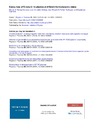Identificador persistente para citar o vincular este elemento:
https://accedacris.ulpgc.es/jspui/handle/10553/42190
| Título: | Energy loss of Fe ions in He plasmas at different thermodynamic states | Autores/as: | Barriga-Carrasco, Manuel D. González-Gallego, Luis Miguel Gil, Juan Rodriguez, Rafael Espinosa, Guadalupe |
Clasificación UNESCO: | 2213 Termodinámica | Palabras clave: | Electron density Equilibrium thermodynamics Plasmas Bound states Stopping power, et al. |
Fecha de publicación: | 2018 | Editor/a: | 1070-664X | Proyectos: | Desarrollo de Modelos Físicos y Su Integración Computacional Para la Descripción Microscópica de Plasmas de Alta Densidad de Energía Implementation of activities described in the Roadmap to Fusion during Horizon 2020 through a Joint programme of the members of the EUROfusion consortium Eurofusión AWP15-ENR-01/CEA-02 |
Publicación seriada: | Physics of Plasmas | Resumen: | In this work, we analyze the thermodynamic states of the helium plasma and their influence on the stopping power calculations which are needed for obtaining the energy loss of the iron beams traversing them. The analysis is made in ranges of plasma free electron densities (10(15)-10(19) cm(-3)) and temperatures (1-10 eV) of experiments with iron beams at 6 and 4.3 MeV/u energies. For this purpose, we use Saha-Boltzmann equations for local thermal equilibrium (LTE) and a collisional-radiative model for non-local thermal equilibrium (NLTE) in steady-state situation implemented in a computer code. For the highest temperatures and free electron densities, LTE and NLTE models provide quite similar results for the average ionization and ion abundances. When the opacity effects are taken into account in the NLTE simulations, the optically thick simulations provide fairly similar results to those of the LTE model. The plasma thermodynamic states have a direct impact on the calculation of the energy loss. The differences on the plasma stopping power between considering it in LTE or in NLTE may entail a 10% of the total stopping for the experiments analyzed in the electron density region of 10(18) -10(19) cm(-3). These differences can be around 27% for plasmas with smaller electron density of 10(17) cm(-3) and around 42% for plasmas with an electron density of 10(15) cm(-3). New experiments would be appreciated to be made in a future to corroborate the latest calculations. | URI: | https://accedacris.ulpgc.es/handle/10553/42190 | ISSN: | 1070-664X | DOI: | 10.1063/1.5050528 | Fuente: | Physics of Plasmas [ISSN 1070-664X], v. 25 (9) |
| Colección: | Artículos |
Citas SCOPUSTM
4
actualizado el 08-jun-2025
Citas de WEB OF SCIENCETM
Citations
4
actualizado el 08-jun-2025
Visitas
116
actualizado el 15-jun-2024
Descargas
219
actualizado el 15-jun-2024
Google ScholarTM
Verifica
Altmetric
Comparte
Exporta metadatos
Los elementos en ULPGC accedaCRIS están protegidos por derechos de autor con todos los derechos reservados, a menos que se indique lo contrario.
